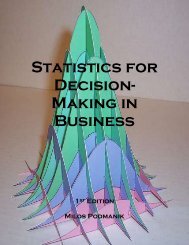Tutor Training Manual.indd - Chandler-Gilbert Community College
Tutor Training Manual.indd - Chandler-Gilbert Community College
Tutor Training Manual.indd - Chandler-Gilbert Community College
Create successful ePaper yourself
Turn your PDF publications into a flip-book with our unique Google optimized e-Paper software.
When asking questions, keep the following in mind:<br />
11<br />
1. Ask open-minded questions. Do not ask questions that require yes or no answers;<br />
instead, ask questions that require elaboration.<br />
2. Allow the student time to answer one question before moving on to the next. Do not<br />
bombard a student with several questions in a row without allowing him or her time<br />
to answer. Also, do not rush a student’s answer. Give him or her time to analyze the<br />
question and answer before moving on to another one. Some tutors will give hints if the<br />
student does not answer in a reasonable time so as not to make the student embarrassed<br />
by lack of knowledge.<br />
3. Mix questioning with other tutoring methods. Asking questions is very important<br />
and very effective, but a session with only questions can overwhelm a student and not<br />
allow the tutor to give enough feedback or instruction. You must learn to ask the best<br />
questions at the most appropriate times.<br />
4. Make questions specific. Try to avoid general questions as much as possible. At times,<br />
you must be general, such as when you ask, “What are you having problems with”<br />
However, always narrow the focus as much as possible once the general questions have<br />
been asked. Specific questions will help a tutor pinpoint the student’s needs.<br />
How to formulate good questions:<br />
Questions should be posed that encourage thinking at each of the following levels of<br />
learning. Often questions only stimulate thinking at the knowledge, comprehension or<br />
application stages. To engage the tutee in active learning it is best to stimulate thinking at<br />
all levels by varying the questions asked.<br />
Level of Learning Type of Thinking Examples<br />
Knowledge<br />
(Remembering)<br />
Remembering or identifying something<br />
without necessarily understanding it, using<br />
it or changing it.<br />
Define…<br />
What is the sum of…<br />
How many are there<br />
Comprehension<br />
(Understanding)<br />
Application<br />
(Applying)<br />
Analysis<br />
(Analyzing)<br />
Demonstrating understanding of the<br />
concepts; transforming, reorganizing or<br />
interpreting.<br />
Using a general concept to solve a specific<br />
problem.<br />
Breaking a problem down into parts and<br />
analyzing conclusions to see if they are<br />
supported by evidence.<br />
In your own words…<br />
Compare…<br />
What is the main idea of…<br />
Calculate the area of…<br />
Apply the rule of…to solve…<br />
Make a graph of…<br />
Interpret the results…<br />
Does the answer seem reasonable<br />
Synthesis<br />
(Creating)<br />
Evaluation<br />
(Evaluating)<br />
Original thinking, plan, proposal, design or<br />
approach.<br />
Judging the value of ideas and offering<br />
opinions.<br />
How would you start<br />
How many ways can you…<br />
What would happen if…<br />
Which method is the most effective<br />
Is there a better solution<br />
Adapted from Education Psychology 9th edition. Anita Woolfolk. 2004

















